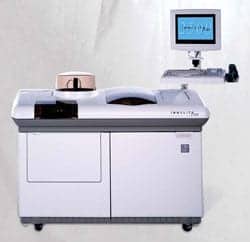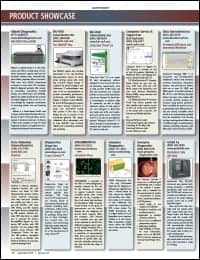 |
Because the risks that laboratory workers take to protect the rest of the population from infectious diseases are part of the day’s routine, these lab staff members rarely get the recognition they deserve for performing the vital tasks of identifying pathogens and evaluating their susceptibility to antibiotics. Without the defenses of the public-health laboratory system and clinical laboratories, the population would be in serious daily danger of epidemic and pandemic infections.
Humans have pictured themselves at the top of the food chain ever since they ceased to be leopards’ regular fare, so it is easy to forget the unseen dangers that surround us. In reality, influenza (covered next month) is the most successful killer of humans so far, and other invisible threats (including viruses, bacteria, fungi, amoebae, parasites, and prions) are always ready to sicken or kill an undefended person.
The core defense, of course, is the individual’s own immune system, and public-health measures such as good sanitation and mosquito eradication also have great impact. Nevertheless, it is everyday laboratory testing that provides early warning of emerging diseases, finds agents that can kill a given pathogen, and helps individuals contain the spread of their incurable infections. The daily round of manual and automated testing for viral, bacterial, and fungal infections should not permit us to forget that laboratory workers are often heroes in the fight against disease transmission, and that some have died in the line of duty.
Recent decades have seen great advances in the ability of laboratories to identify organisms, especially with the advent of molecular diagnostic methods. As the ability to detect pathogens has expanded, it has, luckily, been accompanied by product innovations that keep laboratory staff safer, in addition to helping them work more efficiently and reduce testing costs.
Tests
Xpect Flu A&B and Xpect RSV
 |
For respiratory testing, Remel Inc, Lenexa, Kan, offers two high-performance rapid tests—Xpect Flu A&B and Xpect RSV—for the qualitative detections of associated viral antigens direct from specimen. Both tests feature simple, walk-away procedures that can be performed on all shifts with easy-to-read results within 15 minutes. Rapid diagnosis can reduce the need for secondary testing, cut down on unnecessary antibiotic use, and guide the appropriate antiviral therapy.
Both Xpect respiratory tests can be performed on a variety of specimen types and are compatible with commonly used specimen transports. An 18-month shelf life and room-temperature storage can help reduce waste and cost-reduction efforts.
The simplicity of the procedure that both tests offer improves laboratory workflow during what can be a hectic season with a high demand for rapid respiratory disease testing.
WorkSafe Culture Kit
In May 2007, bioMérieux, Durham, NC, launched its WorkSafe initiative to help laboratories improve the safety of their blood-culture practices (particularly the collection, transportation, and storage or disposal of specimens). The WorkSafe culture kit supports this educational campaign by bringing together all the materials needed for safe specimen collection and handling. It contains BacT/Alert 3D blood-culture bottles, which are made from a multilayer proprietary polycarbonate that can be sent through pneumatic transport systems safely. The kit also contains skin prep, safety collection adapters, and a disposal bag. It reduces the risk of false-positive results for hospital-acquired infection by decreasing the chance of specimen contamination; in addition, it protects workers by eliminating the risk of breakage (and blood-exposure injuries) associated with glass bottles.
TB Prep Kit
Testing for the presence of Mycobacterium species is made considerably more efficient by the use of this kit, available from Hardy Diagnostics, Santa Maria, Calif. The kit holds all the reagents required to conduct decontamination and digestion of specimens, without calling for the use of any labware for mixing or measuring. Five vials each of premixed sodium-hydroxide tuberculosis (TB) digestion solution and premeasured N-acetyl-L-cysteine are included in the kit; they eliminate the need to weigh, filter, and adjust pH before TB testing can begin.
—KK
Instruments
Mastercycler ep Realplex
Eppendorf, Hamburg, Germany, offers this real-time polymerase chain reaction (PCR) system, based on solid engineering and high-quality materials that promote quiet, reliable operation. Its sensitivity is consistently high, and its optical-detection module has only minimal moving parts, to increase the system’s overall stability. Amplification can be completed in less than 30 minutes using a high-speed silver block and impulse PCR technology, supported by a thermal engine of high accuracy. The system’s software is user friendly, but advanced.
Procleix Tigris
From Gen-Probe Inc, San Diego, this is the first molecular-diagnostics instrument to be fully automated. It is used primarily to test donated organs, tissues, blood, and plasma for the presence of major viral pathogens. The Procleix Ultrio assay has FDA approval for use in detecting HIV-1 and hepatitis C virus in individual or pooled samples, and the Procleix WNV assay is approved for West Nile virus testing. Both assays run on the Tigris at a throughput rate of 1,000 samples per 14-hour cycle. While the system can detect hepatitis B virus, it has not yet been approved for screening donated blood for this virus. (A postmarketing study of this capability is in progress.)
Biomic V3
According to Giles Scientific Inc, Santa Barbara, Calif, pathogen identification and antibiotic-susceptibility testing can be performed for $1.50 per isolate using this automated instrument because it eliminates the staff time that would otherwise be required to read and record results. The Biomic V3 is an automated reader for commercial identification panels and standard disk-diffusion tests. It uses an expert system and color digital imaging to provide better consistency, speed, and accuracy than human readers can typically produce. Up to six plates per minute can be read, with automatic quality control and results checking. Bar coding and LIS interfacing eliminate routine data-entry tasks.
311DS Shaking Incubator
Made by Labnet International Inc, Windsor, United Kingdom, this instrument is ideal for culturing bacteria and yeasts. It is highly adaptable, with a broad range of temperature settings that, once selected, are held by the unit’s SmartChek system. The incubator has adjustable shelves (one of which is supplied on initial purchase), various optional flask platforms, and an orbital shaker that is built into its chassis. Viewing specimens is easy because the gasket door’s integral viewing area is large. The chamber is isolated from the system’s electronic components, so they are never subjected to heat stress. The shaker’s orbit is 19 mm, and it stops automatically when the door is opened. Temperatures of up to 70°C can be set and will be held with an accuracy and uniformity of ±0.2°C. Shaking can be continuous or can be set for timed cycles of up to 99 minutes.
Cobas TaqMan 96
This real-time PCR detection system is made by Roche Diagnostics Division, Basel, Switzerland. The high-capacity instrument can handle RNA and DNA amplification and detection for 96 samples at a time, and can run four separate assays simultaneously (because it has four independent thermal cyclers). It can be used with or without its docking station, which is the first completely automated sample-transfer method, and the Cbas AmpliPrep, which prepares samples. An alternative means of automation without the docking station allows the TaqMan analyzer and the AmpliPrep to be networked. The system’s high throughput requires only hours for amplification and detection to be completed. Closed tubes reduce contamination risks, and no user action is needed after sample loading.
3500 Series Shel Labs CO2 Incubators
Sheldon Manufacturing Inc, Cornelius, Ore, has added new features to this incubator series, including an infrared carbon-dioxide sensor that is a standard component of the 3517 model. These incubators can be used with either distilled or tap water in their jackets because of the addition of an anticorrosion anode. Fully coved corners also make these incubators easier to clean. For better access, data-logger connections and the carbon-dioxide sampling port have been relocated to the instrument’s front panel. Contamination is prevented by a high-efficiency particulate air filter in the company’s patented copper housing. Units are supplied with three shelves, but can accommodate up to 16.
Color QCount
Spiral Biotech, an Advanced Instruments Co, Norwood, Mass, manufactures this bacterial-colony counter; it provides rapid color screening, so expensive counting through color differentiation is not necessary. Using sophisticated software and a high-resolution charge-coupled–device camera, it can colorize and identify even Streptococcus pneumoniae and Listeria species (often thought of as among the most difficult-to-count organisms). Throughput and performance levels are both high for this counter, which has a plate-analysis time of less than a second and can process as many as 400 plates in an hour. Its patented image-analysis method uses small shifts in tone to detect colonies. Results can be saved automatically to a spreadsheet or CD-ROM, and plate images become part of a database.
Sensititre Vizion
Susceptibility reports are generated in less than 5 minutes by this instrument, according to TREK Diagnostics Systems, Cleveland, which introduced the digital imaging system earlier this year. Its unique lighting options permit 96-well Sensititre susceptibility plates to be used for organism detection that would otherwise require disk methods. Real-time interpretation and LIS connectivity are features of the system, and images generated by it can be stored for later review. No restarting is required to modify test parameters.
-
- Want to read more? Search for infectious diseases in our free online archives.
Bactec 9000
This scalable series of blood-culture instruments from BD, Franklin Lakes, NJ, can automate continuous testing for laboratories handling fewer than 150 specimens per month using the 9050’s 50-bottle capacity. Larger models can hold 120 or 240 vials; because five instruments can be networked, walk-away culturing can be conducted for 1,200 specimens at once in high-volume settings. This flexibility is accompanied by demographics capture from the LIS or through bar-code scanning, increasing productivity. Samples agitated and incubated according to the desired protocol are assessed every 10 minutes using fluorescent sensors, so positive results can be reported quickly.
That deadly new infectious diseases will continue to emerge without warning seems clear, as the recent lessons of SARS and hantavirus have taught the medical community. Other common pathogens, especially those found in crowded conditions and in institutions, are becoming increasingly resistant to the antibiotics that once held them at bay. Diseases once considered tropical (such as dengue fever and West Nile virus) will travel with their insect vectors as the climate changes, and regional nightmares such as Ebola and Marburg virus will require long-term vigilance if they are to remain contained.
The guard maintained against these killers could be lowered only at society’s peril. Fortunately for us all, the combination of ongoing research, continuing product innovation, and dedicated laboratorians stands between humanity and these invisible predators.
Kris Kyes is technical editor of CLP.
Coming Soon
NanoChip 400
 |
The European CE mark has already been granted to Nanogen Inc, San Diego, for this automated, DNA-based microarray molecular research system (which is not yet available for diagnostic use in the United States). It allows routine, cost-effective multiplexed assays to be conducted without the need to change the laboratory’s current methods of RNA and DNA extraction and amplification. Custom assays also eliminate the need to buy multiple testing systems, and further economies are possible because the cartridges can be reused until their entire 400-test capacity has been used. Pathogen-sequence detection can be performed on multiple samples at the same time, and the risks of human error and specimen contamination are reduced using post-PCR automation (including bar-code reading, sample dispensing, and software-driven reagents).
Versant 440
 |
Also CE-marked, but not yet FDA approved, is this molecular system from Siemens Medical Solutions Diagnostics, Tarrytown, NY. It decreases cross-contamination risks and makes testing simple by using branched DNA technology; there is no need for nucleic-acid extraction. The automated system conducts molecular assays for HIV-1 (RNA), hepatitis B virus (DNA), and hepatitis C virus (RNA). Patient-management concerns can be addressed readily because viral-load changes are easily monitored (due to the high level of reproducibility associated with results). A LIS interface, bar-code data entry, a downloadable patient worklist, and automated reagent processing improve workflow.
—KK





